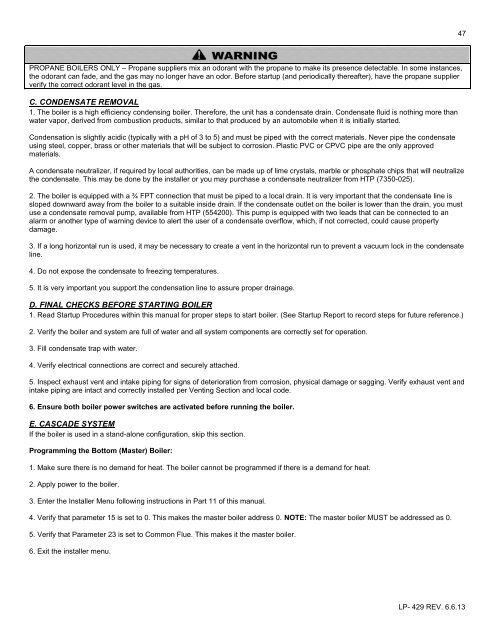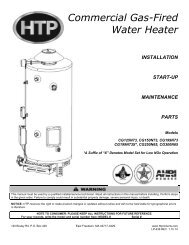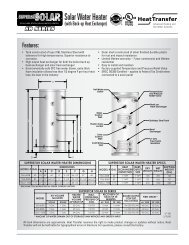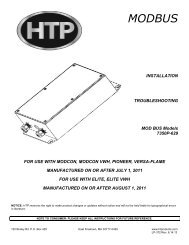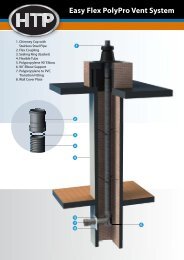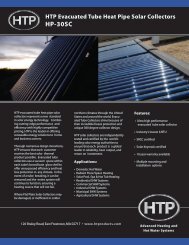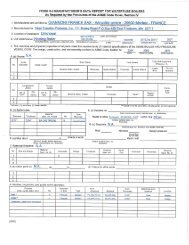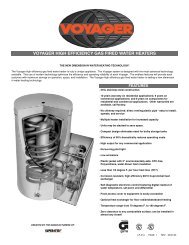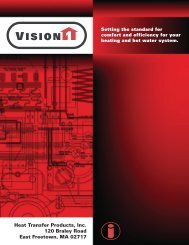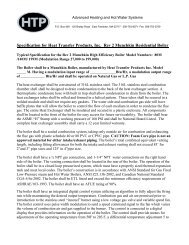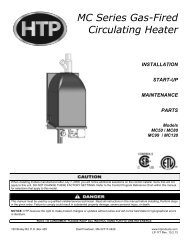Download Installation Manual (.pdf) - Heat Transfer Products, Inc
Download Installation Manual (.pdf) - Heat Transfer Products, Inc
Download Installation Manual (.pdf) - Heat Transfer Products, Inc
- No tags were found...
Create successful ePaper yourself
Turn your PDF publications into a flip-book with our unique Google optimized e-Paper software.
47PROPANE BOILERS ONLY – Propane suppliers mix an odorant with the propane to make its presence detectable. In some instances,the odorant can fade, and the gas may no longer have an odor. Before startup (and periodically thereafter), have the propane supplierverify the correct odorant level in the gas.C. CONDENSATE REMOVAL1. The boiler is a high efficiency condensing boiler. Therefore, the unit has a condensate drain. Condensate fluid is nothing more thanwater vapor, derived from combustion products, similar to that produced by an automobile when it is initially started.Condensation is slightly acidic (typically with a pH of 3 to 5) and must be piped with the correct materials. Never pipe the condensateusing steel, copper, brass or other materials that will be subject to corrosion. Plastic PVC or CPVC pipe are the only approvedmaterials.A condensate neutralizer, if required by local authorities, can be made up of lime crystals, marble or phosphate chips that will neutralizethe condensate. This may be done by the installer or you may purchase a condensate neutralizer from HTP (7350-025).2. The boiler is equipped with a ¾ FPT connection that must be piped to a local drain. It is very important that the condensate line issloped downward away from the boiler to a suitable inside drain. If the condensate outlet on the boiler is lower than the drain, you mustuse a condensate removal pump, available from HTP (554200). This pump is equipped with two leads that can be connected to analarm or another type of warning device to alert the user of a condensate overflow, which, if not corrected, could cause propertydamage.3. If a long horizontal run is used, it may be necessary to create a vent in the horizontal run to prevent a vacuum lock in the condensateline.4. Do not expose the condensate to freezing temperatures.5. It is very important you support the condensation line to assure proper drainage.D. FINAL CHECKS BEFORE STARTING BOILER1. Read Startup Procedures within this manual for proper steps to start boiler. (See Startup Report to record steps for future reference.)2. Verify the boiler and system are full of water and all system components are correctly set for operation.3. Fill condensate trap with water.4. Verify electrical connections are correct and securely attached.5. Inspect exhaust vent and intake piping for signs of deterioration from corrosion, physical damage or sagging. Verify exhaust vent andintake piping are intact and correctly installed per Venting Section and local code.6. Ensure both boiler power switches are activated before running the boiler.E. CASCADE SYSTEMIf the boiler is used in a stand-alone configuration, skip this section.Programming the Bottom (Master) Boiler:1. Make sure there is no demand for heat. The boiler cannot be programmed if there is a demand for heat.2. Apply power to the boiler.3. Enter the Installer Menu following instructions in Part 11 of this manual.4. Verify that parameter 15 is set to 0. This makes the master boiler address 0. NOTE: The master boiler MUST be addressed as 0.5. Verify that Parameter 23 is set to Common Flue. This makes it the master boiler.6. Exit the installer menu.LP- 429 REV. 6.6.13


